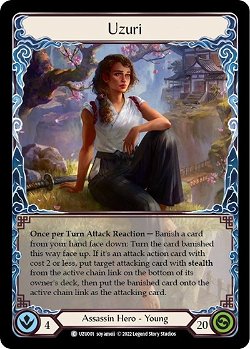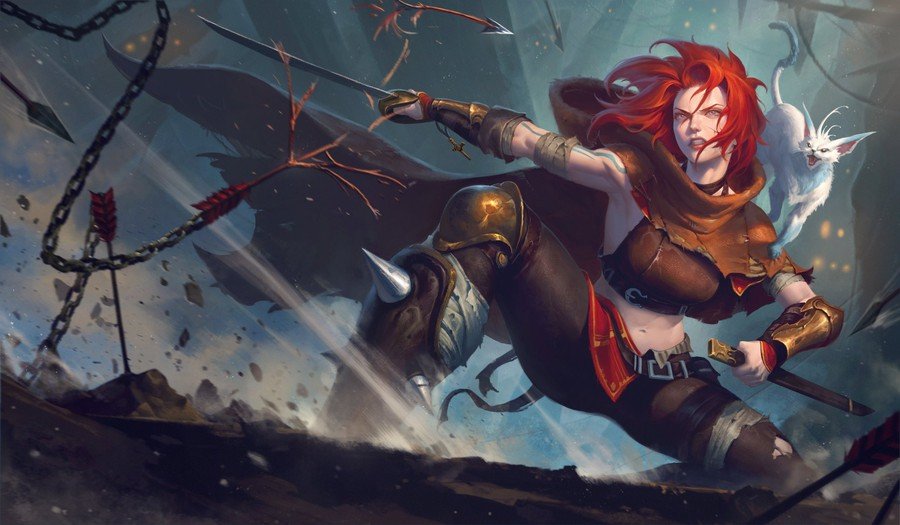Introduction
The Outsiders set has been with us for just under a month, and since then, several lists and tests have appeared with the new cards and mechanics. However, it is the new heroes that most excite players and are the main targets of speculation and fans of their classes.
With this hype and excitement, in the coming weeks I will bring deck techs of the three new heroes to the Blitz format: Uzuri, Riptide and Arakni, Solitary Confinement
Today we'll focus on Uzuri, the new assassin that generated the most excitement in the community! We'll run a breakdown from her precon deck to the most competitive version, following an upgrade guide.
If you're not familiar with the new heroes and set mechanics, I recommend you read my Outsiders review.
Uzuri's Strategy
When the Assassin class was released in Dynasty, the idea was an aggressive-control mechanic where we only attack once a turn (or even twice), exile the opponent's top card and try to drive them to fatigue.
Uzuri's idea is identical in wanting to only hit once a turn and occasionally attack with daggers as well, but her ability adds a surprise factor.

For Magic: the Gathering players, Uzuri's ability is identical to the Ninjutsu mechanic, where we swap the current attack for another one. In more detail, the heroine uses her ability as follows:
After the blockers step, we use her ability (since it's an Attack Reaction) by exiling a two or less cost attack from our hand face down. As soon as this ability resolves, we put the current attack with Stealth on the bottom of the deck and exchange it for the card exiled from our hand, now it is the attacker.
It may seem difficult to understand the first time or when reading the card, but it's simple. Its charm is to make “surprise attacks” presenting a kind of “psychological terror”, making the opponent either perform non-optimized blocks, or block in the best possible way, hoping that the attack is not exchanged.
The Uzuri Precon Decklist
The precon comes with the idea of the heroine-based deck, swapping small attacks with Stealth for bigger and more threatening ones.
There are other ways to build this deck with different themes (such as, for example, using a wide range of cards with Contract), but we will use the one proposed by the precon. It won't be all the cards that will remain on the list until its competitive version, but we'll comment here on the best of this deck, separating them by categories.
Stealth Attacks
For Uzuri's ability, an attack with Stealth must be in the chain link. For this, the list has several low-cost Stealth cards so that we can always attack with one of them on the turn.

Isolate (1) is by far the best stealth attack on the list because it has Dominate - meaning the opponent can only block with one card from their hand. Although its red version has only three power, we are going to exchange it for Uzuri's ability. The idea here is to ensure that the damage from the exchanged card will pass, as only one card was used to block.
Infect (1), Sedate (1) and Wither (2) are the other useful Stealth attacks on the list. Each of them has a different on-hit effect that will give a token to the opponent (it can be Bloodrot Pox, Frailty or Inertia), so even if the attack is not exchanged, the on-hit effect compensates for its consideration in the list.

The last attack on the list with Stealth is Prowl (3), but we won't pay attention to it. This card is much more relevant in Arakni, Solitary Confinement and will be removed in future versions of the deck.
Non-Stealth Attacks
As the idea is to exchange attacks with Stealth, the other attacks we want to “cheat” into play must be stronger than them.

Death Touch (1) is by far the best non-stealth attack in this precon. Its on-hit effect is tailored to your needs in the game, it has a low cost if we are going to play it from the arsenal and its cost/attack power ratio is off the charts.
Humble (1) and Cut Down to Size (1) helps Uzuri with some kind of disruption, while Humble (1) “deletes” the opposing hero's text box (which can really mess up a Dromai, Chane or Briar, for example), Cut Down to Size (1) punishes the chosen opponent for not blocking and with a full hand, causing them to discard a card. These are great preconstructed attacks, and we're going to stick with them for now.
Sneak Attack (1) might not look good when played directly from the hand, but Uzuri's ability is an Attack Reaction, and this causes its power to grow and become 7, which it's a lot of damage - especially if it's unblocked.
The other attacks will be exchanged with the upgrade, but all are on the list with the aim of being "cheated" into the chain link.
Non-attack cards
The list has very few non-attack cards, and since two of them don't fit well with the strategy and will be removed in later versions, we'll only comment on Razor's Edge (3).

Razor's Edge (3) is an excellent Attack Reaction because it costs zero and ensures that damage from a Stealth attack passes through. It is important to remember that several attacks with Stealth have an effect when dealing damage, so even if the deck's version is blue, the important thing is that the attack deals damage.
Still, in situations where we won't use this Attack Reaction, we can pitch to attack with Spider's Bite.
Equipment
The precon equipment is more defensively oriented and is very basic, so we won't pay too much attention to them - since we'll change them all in the first upgrade, but we'll explain them briefly.

Ironhide Legs and Quelling Robe are the defensive equipment (it's important to remember that Quell can be paid multiple times, but it only prevents one from each source of damage), Fisticuffs plays the same role as Razor's Edge (3) but at the cost of two resources.
Mask of Shifting Perspectives allows you to filter your hand every time a dagger deals damage to the opponent and the two Spider's Bite daggers are the best and the standard weapons for any assassin
First Upgrades
The list shows the idea of the heroine well, but it has some problems:
- Several non-stealth attacks lack relevant on-hit effects;
- The deck unnecessarily generates a lot of resources. In other words, the deck has too many blue and yellow cards;
- The deck has defensive cards, but they are not the best and not so necessary;
- The equipment is very basic and doesn't match the deck's proposal.
We're going to keep the preconstructed deck's line of switching attacks, but we'll do it more consistently and more aggressively when we only have Stealth cards in hand.
As for more aggressive options, let's put Back Stab (1), Ravenous Rabble (1) and Scar for a Scar (1).

Ravenous Rabble (1) and Scar for a Scar (1) need no introduction. The two common cards are staples for decks with an aggressive focus. As our plan will involve putting more red cards, Ravenous will probably attack with four power, and Scar will have to go again if we manage our life total.
Back Stab (1) is another Stealth attack that doesn't allow Defense Reactions in its chain link. Although its main objective is to be switched, we can increase its power with the other Attack Reactions on the list while restricting opposing interactions.
To accommodate these additions, we are removing all copies and colors from Sedate (1) as it is the attack that generates the least relevant token for Blitz.
Still in the attacks, we will only change the yellow copies of Wither (2) for the red Wither (1) since we want to be more aggressive.

It's also interesting to put some Attack Reactions, since our Stealth attacks don't have power greater than three, being easily blockable. Let's then put the red version of Razor's Edge (1), Spike with Bloodrot (1) and Razor Reflex (1).
As Uzuri has no cadence, using Razor Reflex (1) is very useful to pass damage and still grant go again to perform another attack. Spike with Bloodrot (1) is, for Blitz, in my view, what generates the most dangerous token for the opponent (since in this format, the hero's life is lower).
To handle these Attack Reactions, we are going to remove the yellow versions of Infect (2), Prowl (3) and Unmovable (3).

We'll also trade copies of Peace of Mind (1) for Sink Below (1) for the card to have no cost and be able to fix your hand, in addition to being one of the best Defense Reactions in the game.
For non-stealth attacks, we are going to make some changes as well. Let's trade Demolition Crew (1) for the new Wreck Havoc (1) as its on-hit effect has value, and take Destructive Deliberation (1) for another Humble (1) because the on-hit effect is more interesting, in addition to the greater power.

In the equipment we will make changes in all of them, placing in the head, chest, hands and feet, respectively:
- Mask of Malicious Manifestations (so you can find a threatening attack from the deck or take out a not-so-useful arsenal);
- Blossom of Spring (to have an extra resource);
- Toxic Tips (to add an on-hit effect to your next attack);
- Snapdragon Scalers (to have more cadence).
We can also put Ironhide Legs on the sideboard as a defensive option and Nullrune Boots, Nullrune Gloves and Arcane Lantern for arcane protection.
At the end, we have the following list:
The Competitive Upgrades
Although the list above is already a beautiful overview of what an Uzuri deck is like, it still doesn't have the best technologies the game has to offer.
So let's go for a second upgrade with better cards. It is important to note that Uzuri is still being studied by players as to which is the best version, and it is not yet known which approach is the most optimized, but we will try to stick to our initial plan.

The first thing we can think of is to put the best two-cost attacks, and of course, we will have Command and Conquer. Even switched, the opponent still cannot play Defense Reactions on the chain link, causing the damage to pass and destroying their arsenal.
Another card that we can put is the Shake Down specialization that has a good power and its on-hit effect is a pseudo discard, bringing a hand interruption. To insert these two attacks, we're going to remove Wreck Havoc (1) and Humble (1).
But we don't necessarily need to use only large attacks. We can also use cards that deal less damage, but with strong on-hit effects, and in them, we can include the Majestics cards from Dynasty Leave no Witnesses, Eradicate and Surgical Extraction

In addition to all having the contract ability (thus banishing the top card of the opponent's deck), these Majestics attacks have an additional effect that greatly hinders the opponent, have a low cost if you want to play them from your hand and are also targets for Blacktek Whisperers and Razor Reflex (1). To include them, we will remove Scar for a Scar (1), the blue version of Infect (3) and Cut Down to Size (1).

Another interesting Dynasty card to put on the list is Shred (3). The Defense Reaction allows the damage to your attack to pass, not increasing your damage, but decreasing the defense of an opponent's card, so we can bypass Sink Below (1) or Fate Foreseen (1).
To place the blue and yellow copies of Shred (2) we will remove the blue copies of Sink Below (1) and Wither (3).

Lastly, we're including two more excellent Attack Reactions. Spreading Plague punishes the opponent if they end up blocking too much by creating Bloodrot Pox, and Concealed Blade adds an effect where you equip a dagger from your sideboard - making good use of Flick Knives, but more on that later. To include these Attack Reactions, we are going to remove all copies of Razor's Edge (1).

In the equipment, we will have profound changes in all slots.
In the head Crown of Providence for its high defense and for fixing your hand and/or protecting your arsenal against a Command and Conquer. Another option is Arcanite Skullcap, since Uzuri has a low defense, and this equipment can help to get around this problem.
On the chest piece, Fyendal's Spring Tunic for offering an extra resource every three turns. Although the list uses several zero-cost attacks, we can use this extra resource to play an Attack Reaction or attack with two daggers, pitching only one blue card. Another option you can use is the new Redback Shroud, which blocks one damage without breaking and decreases your next Attack Reaction of the turn by one.
In the hands, the new equipment, Flick Knives, have already proven to be a staple in all Assassin decks. Its effect breaks one of our daggers to deal its damage to the opponent and make its hit effect (making an analogy, it is as if the dagger was "thrown" at the opponent). Although we lose this dagger for the rest of the game, we can equip another one from the sideboard thanks to the Concealed Blade. It is an excellent equipment to guarantee that one life for the lethal, or when we want to make the effect of one of our daggers at all costs.
In the feet, an old acquaintance of Arakni. Blacktek Whisperers is a pseudo Snapdragon Scalers that has one defense and can come back if broken. Note that we don't use a large amount of cards with Contract, and it is not the focus of this deck to generate Silver tokens, but occasionally, it may happen that we can return this equipment if it is broken. Bear in mind, then, that its primary function is to defend one and grant go again for an assassin attack.

We will still use an arsenal of daggers. Until Dynasty, the only assassin's dagger that existed was Spider's Bite, but with Outsiders, the class gains three more new daggers: Orbitoclast, Nerve Scalpel and Scale Peeler.
Note that they all basically do the same thing, the only difference is which type of card will defend less on the turn. This means that the dagger we use depends a lot on the matchup we are facing (the opponent is a Bravo? Spider's Bite and Scale Peeler. Is it a Dorinthea? Scale Peeler and Orbitoclast, and so on). Also, we need this arsenal to get the most out of Flick Knives / Concealed Blade.
Tips & Tricks
- Try not to extend the game. As Stealth-switched attacks go to the bottom of the deck, we'll have a second cycle full of these attacks that are easily blocked;
- Uzuri's ability causes the attack that will switch places to be exiled face down. Try to respect the times and priorities of the game and reveal only if the opponent lets the ability resolve;
- Prioritize the Bloodrot Pox, but depending on the game, Frailty or Inertia end up being more relevant;
- Use your strong attacks in the beginning and the daggers in the mid-late game, where one damage starts to present risks.
Matchups
The deck doesn't have many secrets when it comes to matchups. Against Wizards, we add all equipment with Arcane Barrier and in the other games we try to be more aggressive than the opponent. The only detail is to pay attention to which daggers to choose. Generally, you will use:
- Spider's Bite in the vast majority of matches where the opponent has attacks;
- Nerve Scalpel against decks with multiple Attack and/or Defense reactions (examples: Dorinthea and Ira, Crimson Haze);
- Orbitoclast against decks who don't try to win with attack cards (like Wizards, Dorinthea and Kassai, Cintari Sellsword)
- Scale Peeler against heroes with high defense equipment, like Oldhim and Bravo
Conclusion
Uzuri is a wonderful heroine with great deckbuilding depth. Adding it brought new visibility into how the Assassin class intends to win the game and breaks down the Contract mechanic used by Arakni, in addition, the more big and good attacks come out during the next releases, the better it gets.
Despite the problems that the class still presents and the lack of certain compatibility of legendary equipment among heroes, Uzuri has already become the passion of several players who explore the best way to play with her and how to make her a contender in the current Metagame.
Thanks for reading! Until next time, where I'll bring you Riptide's deck tech.















— Comentários 0
, Reações 1
Seja o primeiro a comentar